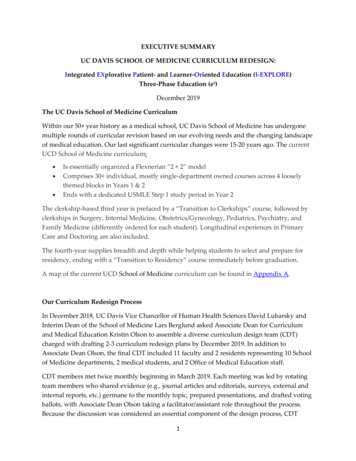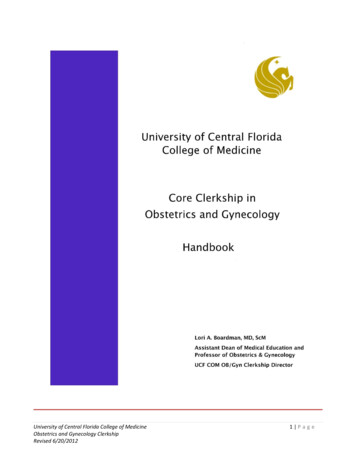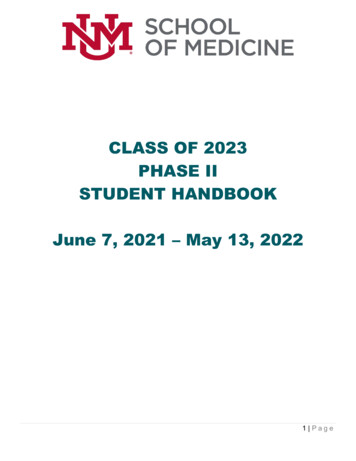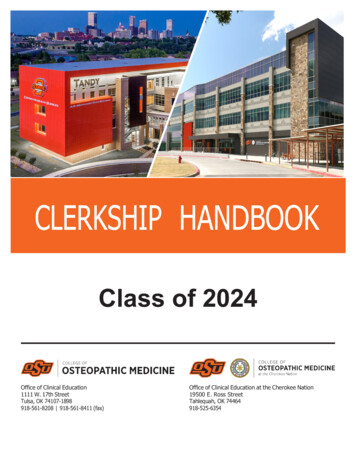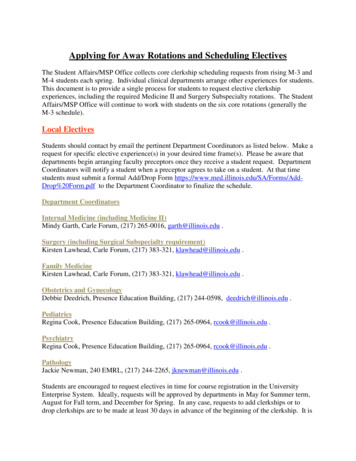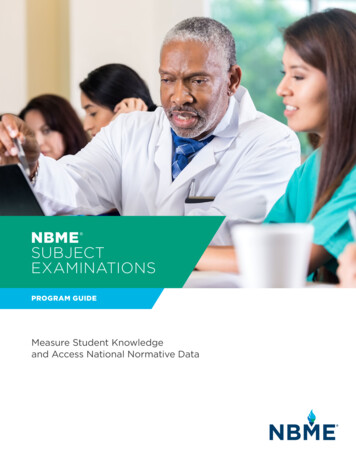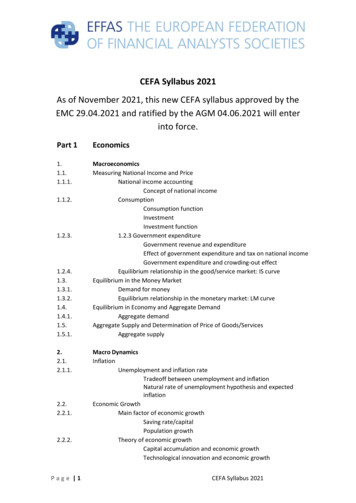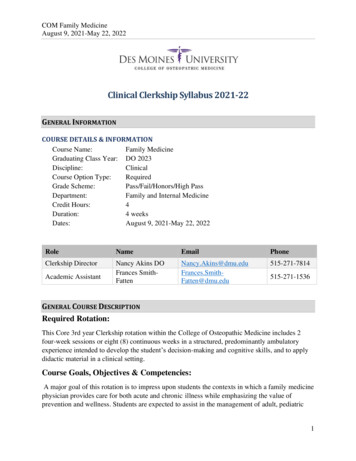
Transcription
COM Family MedicineAugust 9, 2021-May 22, 2022Clinical Clerkship Syllabus 2021-22GENERAL INFORMATIONCOURSE DETAILS & INFORMATIONCourse Name:Family MedicineGraduating Class Year: DO 2023Discipline:ClinicalCourse Option Type:RequiredGrade Scheme:Pass/Fail/Honors/High PassDepartment:Family and Internal MedicineCredit Hours:4Duration:4 weeksDates:August 9, 2021-May 22, 2022RoleNameEmailPhoneClerkship DirectorNancy Akins DOFrances dmu.edu515-271-7814Academic Assistant515-271-1536GENERAL COURSE DESCRIPTIONRequired Rotation:This Core 3rd year Clerkship rotation within the College of Osteopathic Medicine includes 2four-week sessions or eight (8) continuous weeks in a structured, predominantly ambulatoryexperience intended to develop the student’s decision-making and cognitive skills, and to applydidactic material in a clinical setting.Course Goals, Objectives & Competencies:A major goal of this rotation is to impress upon students the contexts in which a family medicinephysician provides care for both acute and chronic illness while emphasizing the value ofprevention and wellness. Students are expected to assist in the management of adult, pediatric1
and geriatric patients. The student will also be given opportunities to perform basic outpatientprocedures.As members of one of the few specialties that sees patients of all age groups and with all mannerof healthcare concerns, family physicians feel that five principles define our profession and guidecare given to all of our patients: Biopsychosocial Model (Patient-Centered)Family Medicine is based on a biopsychosocial model that is patient-centered and teachesstudents to approach patients with sensitivity and responsiveness to culture, age, gender, anddisabilities and develops their ability to collect and incorporate appropriate psychosocial,cultural, and family data into patient-centered management plans. Comprehensive Care (Whole Person Care)Family Medicine emphasizes the importance of caring for the whole person by providingopportunities for students to participate in longitudinal, integrated, preventive services andtreatment of common acute and chronic medical problems for patients and families in all phasesof the life cycle. Continuity of Care (Continuous Health Relationships)Family Medicine values and promotes continuous healing relationships by providing a personalmedical home for patients and their families and maintaining ongoing responsibility for thehealth care of patients and families and facilitating transitions between the primary care provider,referral agencies, and consultants. Context of Care (Evidence-Based)Family Medicine emphasizes the development of patient- and family-centered treatment plansthat are evidence-based, safe, and designed to produce high-quality results that enhancefunctional outcome and quality of life in a culturally responsive manner. Coordinator/Complexity of Care (Integration)The family physician functions as the integrator of complex care and collaborates as a healthcare team member in disease management, health promotion, and patient education.
COM Family MedicineAugust 9, 2021-May 22, 2022AOA COMPETENCIES AND COURSE SCHEDULEThe table below defines each of the seven competency domains set forth by the AOA.AOA Core Competencies petencies/corecompetencyreport2012.pdf?sfvrsn 4 I. Osteopathic Principles andPracticesII. Medical KnowledgeIII. Patient CareIV. Interpersonal andCommunication SkillsV. ProfessionalismVI. Practice-Based Learningand ImprovementVII. Systems-Based PracticeStudents will provide osteopathic care to patients that supports the promotion of health and delivery ofcompassionate, appropriate, and effective treatment of disease based on patient information andpreferences, evidence-based medicine, and clinical judgment.Students will demonstrate knowledge of established and evolving biomedical, clinical, epidemiological,and psychosocial/behavioral concepts and their application to patient-centered care.Students will demonstrate best practices in the delivery of patient-centered care with respect to datagathering and documentation, determination of differential diagnoses and treatment planning,implementation of clinical procedures, and the provision of clinical services consistent with healthpromotion and disease prevention.Students will demonstrate effective listening, speaking, writing, and nonverbal communication skillswith patients or other members of the health care and academic environment.Students will conduct themselves with poise, courtesy, honesty and responsibility when dealing withpatients or other members of the health care and academic environment. Students will engage in self-careand regulation in order to maintain a productive career in medicine.Students will appraise, assimilate, and apply scientific evidence to the care of their patients. They willengage in self-evaluation and life-long learning to ensure optimal patient outcomes.Students will demonstrate a knowledge of health care systems and the resources available to providecomprehensive quality patient care and processes to deal with impediments to patient safety, quality, andaccess to care.This course assesses associated AOA competencies and sub-competencies as noted in the table below.3
COURSE GOALS, OUTCOMES & COMPETENCIESThe goals of this course are to develop a general competency regarding Outpatient and/or Inpatient Family Medicine practice. We wish foreach student to develop a core knowledge of general disease processes and to observe and participate in the coordination of adult, pediatric,and geriatric patient medical care.Objectives have been formulated with the goal of incorporating the seven Core Competencies of the Osteopathic Profession. It is assumedthat appropriate increases in knowledge, skills and attitude/awareness will take place to improve mastery of these competencies. By the endof the Family Medicine clerkship, students will be able to meet the following objectives:Learning OutcomeRecognize the signs andsymptoms, differentialdiagnosis, managementand treatment of thediseases and medicalconditions in the FMCasesPerform appropriatestructural evaluation andtreatment undersupervisionCollaborate with otherhealth care professionalsto provide patientcentered careAOA/AACOM CompetenciesII.1.b, II.1.c, II.1.d, II.1.e,II.1.f, II.1.g, II.1.h, II.1.i,II.1.jI.2.a,I.2.b,I.2.c,I.2.d, I.2.e,I.2.f, I.2.g, I.2.h, I.2.i,I.3.a, I.3.b, I.3.c.1, I.3.c.2,I.3.d, I.3.e, I.3.f, I.3.g,I.3.g.1, I.3.h, I.3.i, I.3.j,I.4.d, I.5.a, I.5.b,I.5.c,I.6.e, I.7.b,I.7.dIII.6.f,III.6.g,III.6.h,IV.3.a, IV.3.b, IV.4.a,IV.4.b, IV.4.c, IV.4.d,IV.4.e, IV.4.f, IV.4.g,IV.4.h,IV.4.i,IV.4.j,IV.4.k IV.4.l,IV.4.m, VII.2.a,VII.2.bEPAsInstructional MethodsAssessment gSelf-DirectedLearningPreceptorshipExam - NationallyNormed/Standardized,SubjectReal tedLearningPreceptorshipClinical DocumentationReviewClinical PerformanceRating/ChecklistReal Patient6,9Clinical Experience –AmbulatoryClinical Experience –InpatientConferencePreceptorshipWard RoundsMultisource AssessmentParticipationReal Patient
Learning OutcomeAOA/AACOM CompetenciesApply osteopathicphilosophy andosteopathic manipulativemedicine as integrativeto the practice of familymedicineI.1.a, I.1.b, I.1.c, I.1.d,I.1.e, I.1.f, I.2.a, I.2.b,I.2.c, I.2.d, I.2.e, I.2.f,I.2.i, I.3.j, I.4.a, I.4.b,I.4.c, I.4.d, I.4.e, I.4.f,I.4.g, I.4.h, I.4.iIII.4.a, III.4.b,III.4.c,III.4.d, III.4.e, III.4.f,III.4.g, III.4.h, III.4.i,Decide informativelyIII.4.j, III.4.k, III.4.l,about diagnostic andIV.1.a, IV.2.a, IV.2.b,therapeutic interventionsIV.2.c, IV.2.d, IV.2.e,using patient informationIV.2.f, IV.2.g, IV.2.h,and preferences,IV.2.i, IV.2.j, IV.2.k,scientific evidence and V.3.a, V.3.b, V.3.c, V.3.d,clinical judgmentV.3.e, V.3.f, V.3.g, V.3.h,V.3.i, V.3.j, V.3.k, V.3.l,V.3.m, VI.1.b, VI.4.a,VI.4.cIII.6.f, III.6.g, III.6.h,IV.3.a, IV.3.b, IV.4.a,Communicate effectivelyIV.4.b, IV.4.c, IV.4.d,with patients, familiesIV.4.e, IV.4.f, IV.4.g,and other healthcareIV.4.h, IV.4.i, IV.4.j,professionalsIV.4.k, IV.4.l, IV.4.m,VII.2.a,VII.2.bDemonstrate respect forpatients and theirfamilies both inside andoutside of care facilitiesV.2.a, V.2.cEPAsInstructional MethodsAssessment MethodsResources1,2,5,6,7Clinical Experience –AmbulatoryClinical Experience –InpatientConferencePreceptorshipWard RoundsClinical PerformanceRating/ChecklistReal Patient1,2,3Clinical Experience –AmbulatoryClinical Experience –InpatientConferencePreceptorshipWard RoundsClinical DocumentationReviewOral Patient PresentationReal Patient8,9Clinical Experience –AmbulatoryClinical Experience –InpatientConferencePreceptorshipWard RoundsClinical PerformanceRating/ChecklistParticipationReal Patient13Clinical Experience –AmbulatoryClinical Experience –InpatientClinical DocumentationReviewOral Patient PresentationParticipationReal Patient
Learning OutcomeAOA/AACOM CompetenciesEPAsInstructional MethodsAssessment MethodsResourcesClinical DocumentationReviewOral Patient PresentationParticipationPortfolio-Based AssessmentReal PatientClinical DocumentationReview ClinicalPerformanceRating/Checklist OralPatient PresentationPortfolio-Based AssessmentReal PatientClinical experience –Ambulatory, Servicelearning activityParticipation, Multi-sourceassessmentReal PatientSelf-directed learning,demonstrationReal PatientConferencePreceptorshipWard RoundsExplain the impact ofcultural diversity onhealth promotion anddisease prevention issuesat the individual andcommunity levelsEvaluate the impact ofethnicity,socioeconomics andenvironment onadherence to treatmentplans and lifestylechangeII.3.f, II.3.g, III.5.a,III.5.b, III.5.c, III.5.d,III.5.e, III.5.f, III.5.g, VI.5V.1.e, V.7.a, V.7.c,VI.5.a, VI.5.b, VI.5.c76,7Experience continuity ofpatient care in acommunity settingI.7.a-d, III.6.a-i, IV.3.ab, IV.4.a-n8,9Formulate healthmaintenance and patienteducation activitiesII.3.f-g, III.5.a-g,VIII.1- 109Case-basedInstruction/Learning—Self-directed, ClinicalExperience –AmbulatoryClinical Experience –InpatientConferencePreceptorshipWard RoundsClinical Experience –AmbulatoryClinical Experience –InpatientConferencePreceptorshipWard RoundsClinical Experience –AmbulatoryClinical Experience –InpatientConferencePreceptorshipWard RoundsClinical Experience –AmbulatoryClinical Experience –Inpatient
Learning OutcomeAOA/AACOM CompetenciesEPAsInstructional MethodsAssessment MethodsConferencePreceptorshipWard RoundsPortfolio-based assessment,Clinical documentationreviewResourcesContent Mapping:Organ SystemScientific Understanding of Health &Disease MechanismsHealth Care crineHematologicAnatomy--abnormalBehavioral health—normalBehavioral rmalPsychiatry--abnormalExamination & Recognition (includesneuromusculoskeletal exam)Gathering Patient InformationHealth care system overviewMedical ethics & medicalprofessionalismPhysician-patient communicationTeamwork & collaboration
Patient Conditions: To ensure a comparable and quality experience while on clerkship, rotations may have a list of patient conditions andprocedures that students must encounter during the experience. Students document exposure to these conditions and procedures throughpatient encounter logging (please see case log section below). If a student does not meet the minimum exposure to a condition orprocedure, an assignment in the form of a video, module, or reading assignment will be available to the student. Below are the patientconditions for this rotation:Patient Condition / Clinical itis (acute)*Well exam*Diabetes**Indicates a core, peer-reviewed diagnosisProcedureCerumen removalJoint injectionPelvic examSkin lesion excision
COM Family MedicineAugust 9, 2021-May 22, 2022STUDENT RESPONSIBILITIESFormative AssessmentStudents are required to request mid-rotation feedback from their preceptor and implement atleast one of the suggested changes. At the conclusion of the rotation, the student will be requiredto write a short summary of what change they made and how it enhanced their education. This ispart of their personal logs and will occur on the site evaluation and is required for passing therotation. Students who encounter barriers in obtaining their mid-rotation feedback should notifythe clerkship director within one week. Students should utilize mobile application technologyand entrustable professional activities as their mid-rotation feedback.Case LogsOne of the mechanisms for monitoring a student’s progress, patient load, rotation experience andcompetency achievement is through the student’s case logs.Students on every clinical rotation are expected to: Complete a daily log of all patient encounterso Each patient encounter requires a diagnosiso Students must ensure the accuracy of the data, including the rotation name.Entering logs under the incorrect rotation name, for instance, is considered asbeing in non-compliance with the case log policy. Students are required to log all patient encounters. If a student is on a low volumerotation, which is defined as less than 15 encounters per week, their clerkship coordinatorshould be notified by the halfway point of the rotation. Students must log non-clinical activities such as residency interviews, board exams,research, didactic activities and absences. If internet access is limited, such as while on an international rotation, paper logs,containing the same information as the electronic logs, must be submitted within 7 daysof the end of the rotation. Logs may be submitted either in person or scanned andprovided via email. Prompt entry of patient encounters is required. Entries must be entered within seven daysof the encounter. Students not in compliance with the case log policy for the first time, will be sent a letterfor that incident of non-compliance. The student is to reply to this letter, including anattestation that the student has reviewed the case log policy in the syllabus, as well asummary of any unlogged activity, within a week from the date of the warning letter.This should be sent to their coordinator and the manager of the Office of Clinical Affairs.There will be no impact on the student’s grade as long as the reply is sent within theallotted time. The second incident of non-compliance, (as tracked in E*Value and by theclerkship coordinator) will result in a referral to the clerkship director for discussion ofprofessional concerns. In addition, students not in compliance with the case log policymay not be eligible for high pass or honors for that rotation. Additional episodes of noncompliance will result in a referral to the COM Academic Progress Committee, mayaffect the clerkship grade and may be noted on the student’s MSPE.9
Students that have technical difficulties submitting logs may contact the Help Desk at515-271-1522 for assistance. Students must also notify their clerkship coordinator oflogging difficulties.Case StudiesStudents are Required to complete 40 assigned AQUIFER FM cases by the last day (Friday)of their 2nd four-week Family Medicine Rotation. Students are required to upload the cases intoan assessment drop box, which is located in the Family Medicine D2L course, for all cases uponcompletion. The Family Medicine Department Clerkship Director and Academic Assistant willelectronically monitor students’ progress and verify that all cases have been completed by the endof the student's last week of rotation.These are interactive web-based cases and students will be required to devote 120 minutes or moreto review and complete. Failure to complete all FM Cases will result in an immediate failure ofthe Family Medicine Rotation. Each FM Case can be remediated by turning in an acceptable 2page paper for each missed case. Guidelines on acceptable will be provided to those who fail tocomplete their cases. See "Instructions" below for viewing FMCases.Instructions for Registering with Aquifer/Aqueduct for FM Cases1.Go to Aquifer.org and click Sign In in the top right corner. This will take you to Aqueduct,our learning management system.2.Enter your institutional email address in the Email box. Then click on the Register button atthe bottom of the page. If you receive a prompt on the screen stating “Please ensure you areusing your institutional email. If registration issue persists, please contact your clerkshipcoordinator.” you may be using the wrong email address, or your email may not have beenrostered in the system by the administrators at your program. Try to register again usingyour official institutional email. If you are not successful, you will need to contact yourcourse director and ask to have your email added to the system.Note: If you have previously registered, you will receive a notification that you have alreadysigned in and you will be re-directed to the sign-in screen.3.You will be sent an email with a link to complete registration. Upon receipt of the registrationemail, click on the link “Click Here “. You will then be brought to the profile setup page.4.You will be asked to fill in your profile information and set up a password (8-characterminimum). Once you have completed your user profile and created a password, you willreceive a welcome email with links to useful information and guides. You would also belogged into the Aqueduct learning management system.5.Once your profile is completed successfully, you will be brought to your institution’s Coursepage.6.You will also receive a “Thank you for registering with Aquifer” email with links to tools,resources, and Aquifer news. (Now your sign in will be quick and easy. Go to Aquifer.organd click Sign In in the top right corner, then enter your institutional email and password.)Supplemental readings may be assigned to address diseases and disorders of patients seenduring clinic hours. During this rotation, the student must make continuing efforts to review
and understand all material listed in order to be adequately prepared for licensureexaminations and college evaluations and must do so by all means available.Site and Preceptor EvaluationStudents are required to complete the site evaluation by the Monday morning after the rotationends.Ensuring Accurate Site, Rotation, and PreceptorStudents are required to ensure that site, rotation, and preceptor information is correct in theclerkship management system. Rotation labels and attending physicians cannot be changed onceany evaluation has been completed for the clerkship. If the student does not know who theattending physician for the clerkship will be, he or she will provide attending information as soonas possible after the rotation begins. If the student does not provide attending information to theOffice of Clinical Affairs by 1700 CST on the Friday before the last week of the clerkship, nocredit will be given for the clerkship. If the student’s preceptor does not ultimately meet DMU’spreceptor credentialing criteria, the student will not get credit for the clerkship.RESOURCES REQUIRED FOR LEARNINGRequired Textbooks and eResources Case Files – Family Medicine by Toy, et al, McGraw Hill 4th Edition, 2012 Clinical Clerkship in Inpatient Medicine by Saint, Lippincott Williams & Wilkins3rd Edition 2010 Taylor’s Manual of Family Medicine by Paulman, et al Lippincott Williams &Wilkins 4th Edition 2015
COM Clerkship Syllabus AddendumCOURSE POLICIESATTENDANCEThe educational hours will be determined by the preceptor and must be in accordance withACGME work hour guidelines. Educational time/hours include clinical time and requireddidactic activities. Maximum educational time on a 4-week rotation is 320 hours, or 80 hours perweek averaged over 4 weeks. Students are expected to be on rotation at least 5 days per week. Ifa student is scheduled by the preceptor for less than 144 hours of educational time on a 4-weekrotation, the student may learn from another preceptor, which preferably would be a physicianbut may also be a physician assistant, nurse practitioner, certified nurse anesthetist, radiologytechnician. If no other preceptors are available, the student must notify their clerkshipcoordinator as soon as possible to arrange for more clinical time elsewhere or a make-upassignment. Students are to be on rotation no more than 6 consecutive days. Students are not todo a shift longer than 28 hours in length, which would be a 24 hour shift plus 4 hours for handingoff care and must have at least 8 hours between shifts.The link to the ACGME Common Program Requirements, which addresses duty hours, Requirements/CPRResidency2019.pdf.ABSENCE POLICYAbsences: Students may miss rotation time for several reasons, which may include illness,residency interviews, and educational conferences/absences. Regardless of the reason for theabsence, the following procedure applies.For excused absences, students are allowed to miss a maximum of two days during a two-weekrotation and four days during a four-week rotation. No more than two days will be approved for asingle event or activity and students are not to miss more than two days in a single week.Planned absences requested over the first two days of the rotation will not be approved.Students missing any time on their rotation must notify the following individuals as soon aspossible: clinical site and preceptor site coordinator, and DMU clerkship coordinator.If the absence is greater than two days and because of illness, students are required to providetheir clerkship coordinator with a physician’s note. Notes from preceptors will not be accepted.The note must address the following: Documentation of the illness Documentation of the resolution of illness and release of the student back to duty.Unexcused Absences: Absences are considered unexcused if the student fails to communicatetheir absence with the preceptor, site contact, and DMU clerkship coordinator or if an absence isnot approved by Des Moines University. Unexcused absences will be tracked over the course of12
the clinical years. For the first unexcused absence, a student will receive a letter of warning. Forthe second unexcused absence, the student will receive a letter of warning and be referred to theAcademic Progress Committee. If the student has a third unexcused absence during their clinicaltraining, it will result in rotation failure.Absences for Residency Interviews and Board Exams: Students may be absent from clinicalrotations for board exams and residency interviews. The following guidelines apply for thesespecific circumstances: Students are encouraged to give as much notice to their clinical site and clerkshipcoordinator as possible when scheduling residency interviews. Des Moines Universityrequests at least 14 days’ notice when scheduling residency interviews. Exceptions can bemade if a student is offered a last-minute interview spot, pending the approval of theclinical site. Exceptions may be made for maximum number of days missed from rotation toaccommodate residency interviews. This is on a case-by-case basis and factors taken intoaccount include:o Total number of planned absences already scheduled during the rotationo Number of days already planned to be missed during the same week as thepending requesto Days already missed from the rotation due to illnesso Structure of the rotation such as hours scheduled and ability to make up theclinical timeo Site specific policies regarding the maximum number of missed days allowedduring the rotation All residency interview absences must be approved by the clinical site. Sites frequentlyhave their own policies for maximum number of days missed from a rotation andminimum notice required for absences. In the case where a site’s policy is morerestrictive than the Des Moines University policy, Des Moines University will honor thesite’s policy. If missing a significant amount of time from a rotation for residency interviews, a studentmay be required to use time off in order to accommodate the time away from rotations. Board exam days are credited as clinical time, but travel days to the board exams areconsidered days off from rotations.Conference Absences: Students are encouraged to engage in non-clinical learning opportunitieswhile on clinical rotations. For this reason, all students are allowed one educational absence, upto two days, each academic year. The following provides guidance for students to receivepermission and credit for these activities. Each student can be approved for up to one conferenceabsence per academic year. Some examples of educational activities include: OMM-related education activities for OMM Fellows, as approved by the OMMDepartment ChairParticipation in national or state osteopathic, medical, or student boards/committees (e.g.AOA, ACOEP, ACOFP, COSGP, UAAO, AMSA, IOMA, etc.)Other educational activities as preapproved by the clinical site and Associate Dean forClinical Affairs
Attend a medical conference for networking with residenciesMaster’s courses required for dual degree studentsAdditional items to consider when requesting an educational absence follow: All educational absences are subject to the approval of the clinical preceptor, rotationsite, and Office of Clinical AffairsIn addition to the approval process outlined above, any educational absence that will begreater than two days will require any days greater than two days missed to be made up.Make up for educational absences must be clinical time outside time already scheduledon the rotation.When requesting the educational absence of greater than two days, the student shouldoutline a plan for making up time otherwise the request may be sent back to the studentor denied. If the time greater than two days missed cannot be made up with clinicalexperience, the request will be denied.The student may work with his or her preceptor, clerkship coordinator, Director ofUndergraduate and Graduate Development, or Associate Dean for Clinical Affairs ifneeding assistance in creating a make-up plan.All requests should be submitted via Special Circumstance and at least 30 days prior tothe date of the requested time off. Failure to adhere to this 30-day policy may result indenial of the request.As with all absences, all educational absences must be logged.Approval for an educational absence is subject to the student’s overall academic andprofessional record.Travel to and from any activity is not considered clinical education time and will beincluded in the student’s case log.Students are responsible for travel and conference expenses.Any student absent from clinical rotations for an educational absence without seekingprior approval is in violation of this policy and may be subject to disciplinary action.Leaves of Absence: Any extended absence, including those due to illness or family emergencies,may require the student to take a voluntary leave of absence (LOA). The student would have anopportunity to make up missed clerkship time at a later date. An LOA may delay the student’srotation schedule and subsequent advancement to the next academic year, graduation and/ormatch and residency.Make-up Policy: Students will be required to make up excused missed rotation time if they missmore than two shifts in a week or the maximum missed time allowed for rotations as outlinedunder the “Attendance” heading. Students may make-up missed time by doing one of thefollowing: Participate in clinical activity at the site on a weekend. This is the preferred make-upactivity and will be the expected make-up plan if the site has weekend or extendedweekday hours. If the rotation is at a site without weekend hours, the missed rotation time may be madeup in the form of an assignment which may include:o Online modules
o Reading assignmento Research or practice improvement projecto Reflection paperThe student’s preceptor may be consulted when determining the requirements of the assignment.When notifying their clerkship coordinator of the missed time, the student should include a planfor making up time missed greater than two days. The student may work with his or herpreceptor, clerkship coordinator, Director of Undergraduate and Graduate Development, orAssociate Dean for Clinical Affairs if needing assistance in creating a make-up plan. Studentswho do not make up missed rotation time may delay their progression to the next academic year,graduation and/or match eligibility.Didactic sessions missed will be made up as decided by the clerkship director on a case-by-casebasis. Post rotation exam make-up is discussed in the Post Rotation Exam Policy section.Holiday Policy: Students are expected to be on rotation on holidays unless the facility is closedand/or they are told not to attend by their preceptor or site contact. As with all absences fromrotation, regardless of reason, holiday absences must be logged in the case logs.Inclement Weather Policy: Students will likely encounter inclement weather during theirclinical years. If a student has been notified by the site that s/he is not expected on rotation dueto inclement weather, the student should select a reading topic to do from home. If a studentfeels that his or her safety is at risk if traveling to rotation in inclement weather, he or she mustnotify the site, preceptor, and DMU clerkship coordinator immediately of the decision to be athome and, in addition, notify his or her coordinator of the topic they will study from home. Aswith all absences from rotation, regardless of reason, inclement weather absences must be loggedin the case logs.EVALUATIONExaminations
Clinical Clerkship Syllabus 2021-22 GENERAL INFORMATION COURSE DETAILS & INFORMATION Course Name: Family Medicine . Academic Assistant Frances Smith-Fatten Frances.Smith-Fatten@dmu.edu 515-271-1536 . treatment of common acute and chronic medical problems for patients and families in all phases
